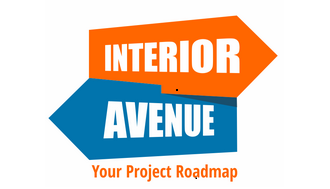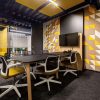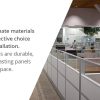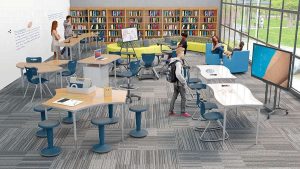How Schools Can Get Better Furnishings With More Funding Options
How Schools Can Get Better Furnishings With More Funding Options
Public schools in the United States are primarily funded by state and local governments. The majority of funding comes from state governments, with local funding coming primarily from property taxes. The state and local governments allocate funds to the schools based on a variety of factors, such as the number of students and the needs of the school district. Schools can also receive funding from the federal government through programs such as Title I and the Individuals with Disabilities Education Act (IDEA). Additionally, public schools may fundraise or receive donations from private individuals or organizations to purchase school furniture.
School Library
Gilbert, AZ

How often do schools buy furniture?
The frequency at which schools buy new furniture can vary depending on a number of factors, including the age and condition of existing furniture, the budget of the school district, and the specific needs of the school. Some schools may need to purchase new furniture more frequently than others, depending on the wear and tear of the existing furniture and the size of the student population.
In general, it may be assumed that most public schools will purchase new furniture as necessary, such as when existing furniture is damaged or no longer safe for use. Some furniture like student desks, chairs, and tables, may have a shorter life expectancy due to frequent use and can be replaced more frequently. Other items, such as laboratory equipment and theater seating, may have a longer lifespan and may not need to be replaced as frequently.
Classroom
Chandler, AZ

However, it is also important to note that some school districts may have a replacement schedule for all furniture to maintain a certain standard. Such schedule can be based on the age of the furniture, the usage, and the budget of the school district.
What percentage of schools lease furniture?
Leasing furniture is not a common practice for schools, as most schools prefer to purchase their furniture outright. Schools may choose to lease furniture in some cases, such as when they need a specific type of furniture for a short period of time, or when they lack the budget to purchase the furniture outright.
It is worth noting that some school districts may have a lease-to-own agreement with the vendor, where they pay a monthly fee to use the furniture and after a certain period of time, the furniture is owned by the school district.
Leasing furniture is more common in commercial settings, such as office spaces and retail stores, rather than in schools.
It is difficult to provide an exact percentage of schools that lease furniture, as it can vary depending on the location, school district, and budget. However, it is not a common practice for schools to lease furniture. Most schools prefer to purchase furniture outright, as it allows them to own the furniture and have control over its use and maintenance.
Leasing furniture can be an alternative for schools that have limited budget, and prefer to conserve capital for other expenses. Schools can also lease furniture for temporary use, for example for a specific project or event that is happening in the school.
It is important to note that leasing furniture can be more expensive in the long run, as schools will be paying for the use of the furniture over time, rather than just paying for it once. Schools also lose the ability to own the furniture and may have to return it at the end of the lease period.
In conclusion, it is not a common practice for schools to lease furniture, but it can be an alternative for schools that have a limited budget or need furniture for a specific project or event.
Classroom Lounge
Tempe, AZ

What products do schools lease?
Schools can lease a variety of products, including furniture, technology, and equipment. Some common products that schools may lease include:
- Furniture: Schools may lease furniture such as desks, chairs, tables, and storage units for classrooms and common areas.
- Technology: Schools may lease computer equipment, such as laptops, tablets, and interactive whiteboards, for use in classrooms and computer labs.
- Audio-Visual equipment: Schools may lease audio-visual equipment such as projectors, speakers, and sound systems for use in auditoriums, gymnasiums, and classrooms.
- Musical instruments: Schools may lease musical instruments for use in music classes or band programs.
- Laboratory equipment: Schools may lease laboratory equipment such as microscopes, chemicals, and other materials for use in science classes.
- Athletic equipment: Schools may lease athletic equipment such as scoreboards, mats, and weightlifting equipment for use in physical education classes and sports teams.
It is important to note that schools may choose to lease equipment or furniture for temporary use, for example for a specific project or event in the school. Leasing can also be an alternative for schools that have a limited budget and prefer to conserve capital for other expenses.
Makerspace Classroom
Mesa, AZ

How long do schools keep old furniture?
The length of time that schools keep their old furniture can vary depending on a number of factors, including the condition of the furniture, the school’s budget, and the specific needs of the school.
In general, most schools will replace old furniture when it is no longer safe or functional. For example, if a desk is broken or a chair is falling apart, the school will likely replace it as soon as possible to ensure the safety and comfort of the students.
Some schools may choose to keep old furniture for a period of time, for example, if they have a limited budget and cannot afford to replace it immediately. In this case, the old furniture will be kept until the school can afford to replace it, or it can be donated or sold as surplus.
Additionally, some schools may keep certain older furniture as historical pieces or for sentimental reasons. Such furniture may be used for display or for educational purposes.
In general, schools tend to keep old furniture for as long as it remains safe and functional but will replace it as soon as the budget allows or if necessary for the safety or comfort of the students.
Modular Lounge
Gilbert, AZ

Are rows of desks going away in the classroom?
Rows of desks in classrooms have been a traditional layout for many years, but it is becoming increasingly common for schools to consider alternative layouts. Research has shown that traditional classroom layouts, such as rows of desks facing a teacher, can be limited to student engagement and interaction.
One of the most popular alternatives to the traditional classroom layout is the flexible seating classroom. Flexible seating classrooms often feature a variety of seating options, such as beanbag chairs, standing desks, and cushions, which allow students to choose the seating option that best suits their needs. This type of classroom layout encourages students to be more active and engaged in their learning, and can also promote collaboration among students.
Another alternative to traditional classroom layout is the use of collaborative and interactive furniture, such as round tables, whiteboards, and writable surfaces. This allows for more interactive and collaborative learning and can be used in a variety of ways, from group projects to individual work.
It’s worth noting that the trend of changing classroom layouts is not a one size fits all solution, and some traditional layouts may work better for certain subjects or grade levels. Ultimately, whether or not rows of desks are going away in the classroom depends on the preferences of each school, teacher, and district, and the budget available for furniture.
Need to upgrade your school furniture? Need classroom furniture? We can help. Reach out today for a free project roadmap and budget.
School furniture in Gilbert, AZ
School furniture in Chandler, AZ
School furniture in Mesa, AZ
School furniture in Tempe, AZ
Computer Lab
Chandler, AZ









Leave a reply